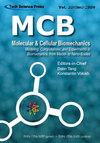Using 3D Thin-Layer Model with in Vivo Patient-Specific Vessel Material Properties to Assesse Carotid Atherosclerotic Plaque Vulnerability
Q4 Biochemistry, Genetics and Molecular Biology
引用次数: 1
Abstract
Image-based computational models have been introduced to calculate plaque stress/strain conditions and investigate their association with plaque progression and rupture [Tang, Yang, Zheng, et al. (2004)]. However, the accuracy of the computational results is heavily dependent on the data and assumptions used by those models. Patient-specific vessel material properties are in general lacking in image-based computational models, limiting the accuracy of their stress/strain calculations. A noninvasive approach of combining in vivo 3D multi-contrast and Cine magnetic resonance imaging (MRI) and computational modeling was used to quantify patient-specific carotid plaque material properties for potential plaque model improvements [Wang, Canton, Guo, et al. (2017)]. The stress-based plaque vulnerability index (SPVI) was proposed to combine mechanical analysis, plaque morphology and composition for more complete carotid plaque vulnerability assessment.使用具有体内患者特异性血管材料特性的3D薄层模型评估颈动脉粥样硬化斑块易损性
基于图像的计算模型已经被引入计算斑块应力/应变条件,并研究它们与斑块进展和破裂的关系[Tang, Yang, Zheng, et .(2004)]。然而,计算结果的准确性在很大程度上取决于这些模型所使用的数据和假设。基于图像的计算模型通常缺乏患者特定的血管材料特性,从而限制了其应力/应变计算的准确性。采用一种无创的方法,结合体内三维多重对比和磁共振成像(MRI)以及计算建模,量化患者特定的颈动脉斑块材料特性,以潜在地改进斑块模型[Wang, Canton, Guo等(2017)]。提出基于应力的斑块易损性指数(SPVI),将力学分析、斑块形态和组成相结合,更完整地评估颈动脉斑块易损性。
本文章由计算机程序翻译,如有差异,请以英文原文为准。
求助全文
约1分钟内获得全文
求助全文
来源期刊

Molecular & Cellular Biomechanics
CELL BIOLOGYENGINEERING, BIOMEDICAL&-ENGINEERING, BIOMEDICAL
CiteScore
1.70
自引率
0.00%
发文量
21
期刊介绍:
The field of biomechanics concerns with motion, deformation, and forces in biological systems. With the explosive progress in molecular biology, genomic engineering, bioimaging, and nanotechnology, there will be an ever-increasing generation of knowledge and information concerning the mechanobiology of genes, proteins, cells, tissues, and organs. Such information will bring new diagnostic tools, new therapeutic approaches, and new knowledge on ourselves and our interactions with our environment. It becomes apparent that biomechanics focusing on molecules, cells as well as tissues and organs is an important aspect of modern biomedical sciences. The aims of this journal are to facilitate the studies of the mechanics of biomolecules (including proteins, genes, cytoskeletons, etc.), cells (and their interactions with extracellular matrix), tissues and organs, the development of relevant advanced mathematical methods, and the discovery of biological secrets. As science concerns only with relative truth, we seek ideas that are state-of-the-art, which may be controversial, but stimulate and promote new ideas, new techniques, and new applications.
 求助内容:
求助内容: 应助结果提醒方式:
应助结果提醒方式:


